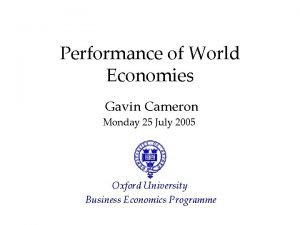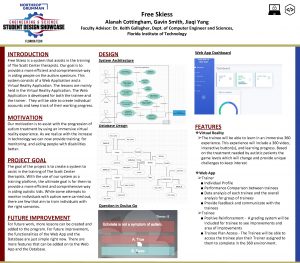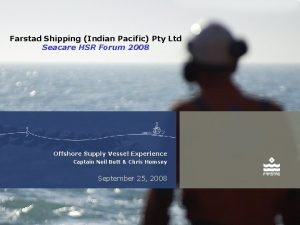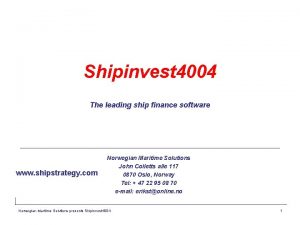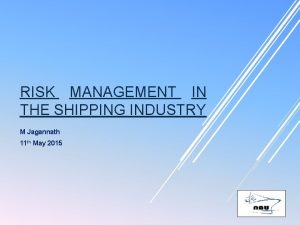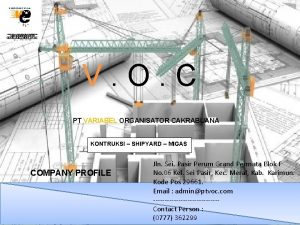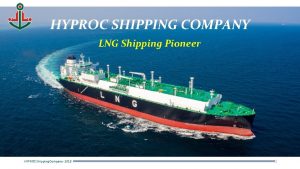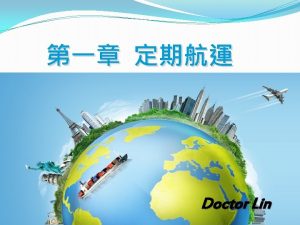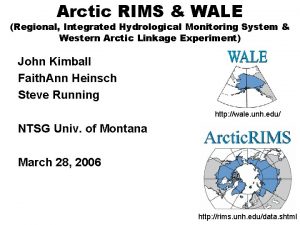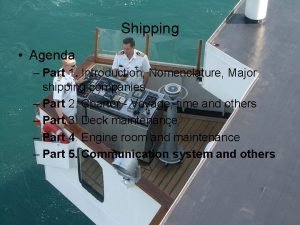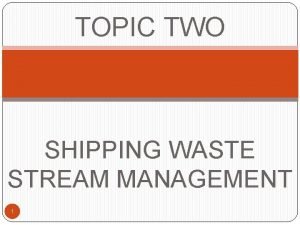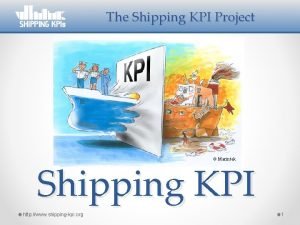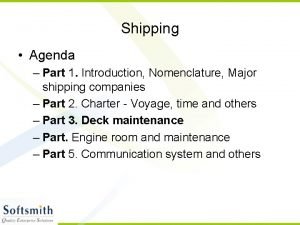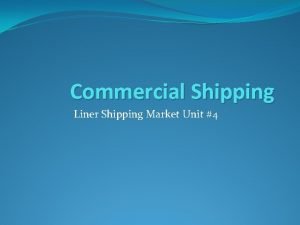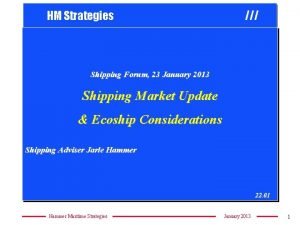Shipping Networks Week 1 Shipping Networks Gavin Wale


































- Slides: 34

Shipping Networks Week 1

Shipping Networks Gavin Wale

Background • According to the World Trade Organization, the worldwide merchandise trade was estimated worth an 18. 3 trillion US$ in 2013 , which is a worldwide annual increase of 5. 3% compared to 2012. The largest proportion of worldwide trade is transported by sea: 80% of the weight and 70% of the value (see UN Conference on Trade and Development (2013))

Importance of Ports • Much of the world’s welfare today has been produced, or is helped, by sea ports and their related activities. • Ports are the place where trade, logistics and production meet. • Ports and their network connections have experienced a lot of growth over the last decades. As a result many ports and surrounding areas have benefited. • The economic activity associated with international trade means that an efficient transport system is vital for an areas economic mobility.

What is a port? Many different definitions exist about ports. Stopford (2009: 81) defines a port as “a geographical area where ships are brought alongside land to load and discharge cargo- usually a sheltered deep water area such as a bay or river mouth. ”

Types of Ports • There are two main types of ports. -Inland ports- these are located next to rivers. -Sea ports- these are located in harbours. • They can be divided into single purpose ports and multiple purpose ports. -Single purpose ports – deal with one commodity. - Multiple purpose ports – deal with different commodities (containers, dry bulk, liquid, cars…. . ) - Most ports are found in Europe and North America……Why do you think that is?

Ports • Ports have generally grown in size and efficiency along with the global economy. • For many products, production and consumption are scattered worldwide. • Ports play an important role in connecting these points of production and consumption and establishing global supply chains. • Ports can be considered as nodes in global logistics networks, where maritime transport and hinterland transport meet.

• Node - a point at where other things meet. • Hinterland the area that surrounds a big city or port and on which the city or port depends for economic growth: • (Cambridge dictionary)

Role of Ports • Primarily, ports serve as transfer points in a transport chain. • They are also a location for industry and logistics. • It is these three functions that we will look at. It is important to remember that they are highly different. • Each function has different companies that provide the services, different scales of competition (one port may be stronger in one area and another in another). • Because there are 3 main functions it is hard to measure port performance.

Performance Indicators • The ports performance can be measured in a few ways. • Worldwide throughput is most used in the industry. • Throughput = the average quantity of cargo that can pass through a port on a daily basis from arrival at the port to being loaded onto a ship or from the discharge from a ship to the exit. It is usually measured in tons. • Throughput can also be measured in time. For example how long it takes to load or unload containers or how long trucks have to spend waiting to unload or load containers. • Port-related employment and value added are also used. • We will look at these in more detail later and in the next few weeks?

A part of the transport chain • Ports have a similar role to play in the transport chain as airports and bus stations. However, rather than people they are focused on cargo. • Types of cargo: • Bulk cargo- coal, grain and iron ore. • Liquid bulk- crude oil and liquified petroleum gas (LPG). • General cargo- steel, wood and fruit ( differs from the others because it can be counted) • Container cargo- stored in standardised boxes. • Roll on/off cargo – cars and trucks. • Project/ specialised cargo

A part of the transport chain • Ports are nodes in the transport chain because cargo needs to be exchanged. • De Wit and Van Gent (2001) state 3 reasons why these nodes are important. • 1 - They are needed to connect the different types of transport. Ships take large quantities great distances and trucks take the smaller things to its final destination. • 2 -They are facilitators of international trade. Countries sell what they have an abundance of and buy what they need. Transport is required for this and the amount is dependant on the amount of trade. A change in this can have a large effect on ports. Goods can be combined at ports to increase efficiency and economies of scale. • 3 - They can be used as storage.

Important people in the chain • Deep-sea terminal operator (stevedore or terminal operating company) -responsible for loading and unloading ships and the temporary storage of the goods. -usually focus on one type of cargo because of the specialisation of equipment. -Customers are usually shipping lines and shippers. -Some terminal operators are in ports all over the world, while others are just in one port.

• Shipping line • - The core business is to operate ships and provide shipping services. • -shipping companies do not always own ships. • They usually sell space on the ships they run to shippers.

• Forwarder • They have knowledge of transport possibilities and prices. They use this knowledge to provide a door-to-door transport solution for a shipper. • They negotiate prices and consolidate small shipments into large loads. • They take care of the paperwork.

• Shipbroker • Another intermediary like a forwarder. • Acts as an agent for the shipowner. They are responsible for the business side of the ship. They obtain cargo from shippers, arrange port activities like (un)loading, insurance and customs clearance.

• Port-related transport companies for transport by rail, waterway or road. • There are many ways to get the cargo to and from the port. These include rail, waterways and road. • The areas around ports are usually congested due to the popularity of using trucks. • Trucks are popular cause they can take the cargo all the way to the final destination.

Other important people and services. • Providers of nautical services. • Pilots manoeuvre ships through the ports and berths and assist with (un)berthing. • They are usually a public organisation because the role they play in ensuring the safety of the port. • Towage companies provide tugboats to assist the ships in the port. • Mooring companies are specialised in attaching the ships to the quay. • These companies are paid by the shipping lines for their services.

• Port Authority • These can be public or private institutions. They are responsible for the planning development and safety of the port. • Landlord port authorities provide the land basic infrastructure and leave all other activities to private firms. • They make money by collecting port dues from shipping companies and land rents from terminal operators and other port related industries.


The functions of a port • Port as a transport node • Port as a location for industrial activities • Port as a location for logistics activities.

The functions of a port • The (un)loading of ships and the storage of goods are the main activities of a port. • The competitive position of a port as a transport node is determined by its geographical location. • Ports need to secure nautical accessibility, have good physical infrastructure, good availability of transportation services. • They also rely heavily on the service providers contained in the port. Their efficiency determines the success of the port.

The process of a port

Ports functions

Measuring Port Performance • Measuring the performance of ports is a complex task. • This is because a port contains many functions, activities and companies. • Performance in the terminal might be linked to efficiency (moves per hour). • Performance in the warehouse might be linked to the occupancy rate. • Performance in a production facility might be the output produced. • These individual activities can be measured relatively easily but it is more difficult to measure them as part of a complete system.

Throughput • Throughput in tons is the most used measurement of port performance. • This measurement can be compared to similar ports in the region. For example Rotterdam, Hamburg, Le Harve compete for the same cargo. • The total throughput reflects to some extent the size of the port. However, every type of cargo requires different activities in handling them and therefore does not give an insight into the performance and competitiveness of the port. A conclusion can be drawn when comparing cargo categories.

Port as a location for industry or logistics activities • When the port is viewed as a location, whether it is for industry or logistics activities such as warehousing, the throughput measure is no longer a suitable measurement. • It is important to look at how much activity takes place rather than how many goods are processed. • The performance indicator that best shows the economic activities is the value added, and the socio -economic goals. • It should be remembered that many port activities take place not only in the port but also in the surrounding areas.

Private investments • This represents the trust that companies have in the port. • When investment in fixed assets is high, it reflects the future opportunities of the port.

In the port of Rotterdam, the investment levels have grown in the period from 2010 onwards (Figure 1. 5). An important driver for that is the realisation of the Second Maasvlakte, a 1, 000 -hectare expansion of the port that induced new private sector investments in container terminals. In addition, several industrial sites, mainly related to the oil and chemical industry, made upgrade investments in their installations. Ports and Networks (p. 20). Taylor and Francis. Kindle Edition.

How can ports increase their value • Port authorities try to influence the total performance of their port, not only in efficiency but also in terms of economic value for the region. • Port authorities that only try to maximise profit are scarce. They usually have a strategic plan. • 1 -Attract more port related business to the port. • 2 -Create cluster synergies. • 3 -Increasing the logistic value of the port.

Attract port-related business • Port authorities try to fill their land with relevant businesses. • To increase value they may target specific businesses to compliment existing businesses or to start a new development. • Neste’s refinery of biomaterials in Rotterdam is an effort to start a broader biobased cluster in the port.

Create cluster synergies • Putting businesses that compliment each other close together enables them to benefit from support networks, infrastructure and resources. • An example of this is the multicore pipeline in Rotterdam. This was put in place by the port authority and Vopak, a liquid bulk storage company. The pipeline connects many industries around the port.

Increase logistic value • The core function is to connect regions through maritime transport. • The value comes from the cargo it handles, transshipped, and further manufactured. • Transshippment creates value because getting cargo to the right place increases its value. A lot of value is created in this process from port payments and employment. • Adding distribution parks can add value. An example of this is the 3 distribution parks in Rotterdam. This adds logistics value to the port.

Conclusion • The primary function of a port is being a node in a transport chain. • Ports can connect different modes of transport and enable storage. • They also include other business activities linked to sea transport.
 Warum sind wale keine fische
Warum sind wale keine fische Przykłady dźwigni jednostronnej w życiu codziennym
Przykłady dźwigni jednostronnej w życiu codziennym Wale sonar
Wale sonar Liner shipping and tramp shipping
Liner shipping and tramp shipping Week by week plans for documenting children's development
Week by week plans for documenting children's development Let's divide and conquer
Let's divide and conquer Suny central administration
Suny central administration Causes of cyanosis
Causes of cyanosis Gavin kearns
Gavin kearns Gavin swann
Gavin swann Ending gavin ewart
Ending gavin ewart Gavin davies imperial
Gavin davies imperial Gavin baldwin
Gavin baldwin Wendy gavin
Wendy gavin Gavin soorma
Gavin soorma Gavin cameron
Gavin cameron Andrew pryfogle
Andrew pryfogle Gavin cotter
Gavin cotter Gavin corey
Gavin corey Gavin cameron
Gavin cameron Gavin is designing a kite
Gavin is designing a kite Pc gavin smith
Pc gavin smith Ifrs 9
Ifrs 9 Gavin greenfield
Gavin greenfield Camden council structure chart
Camden council structure chart Gavin smith wren academy
Gavin smith wren academy Gavin cook princeton
Gavin cook princeton Gavin giovannoni
Gavin giovannoni Gavin cameron
Gavin cameron Backbone networks in computer networks
Backbone networks in computer networks Virtual circuits and datagram networks
Virtual circuits and datagram networks Ane farstad butt
Ane farstad butt Shipping financial software
Shipping financial software Risk management in shipping industry
Risk management in shipping industry Pt barra asean shipping
Pt barra asean shipping



















